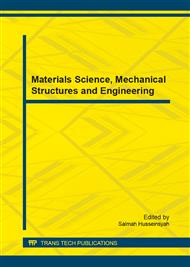[1]
A. Palomo, M.W. Grutzeck, M.T. Blanco, Alkali-activate fly ashes: a cement for the future. Cement Concrete Res. 29 (1999) 1323-1329.
DOI: 10.1016/s0008-8846(98)00243-9
Google Scholar
[2]
R. V. Rangan, Low-calcium fly-ash based geopolymer concrete, In: Nawy EG, editor. Concrete construction engineering handbook. New York: CRC Press. (2007).
DOI: 10.1201/9781420007657.ch26
Google Scholar
[3]
J. Davidovits, Geopolymer: inorganic polymeric new materials. J Therm Anal 37 (1991) 1633-1656.
Google Scholar
[4]
P. Duxson, J.L. Provis, G.C. Lukey, J.S.J. van Deventer, The role of inorganic polymer technology in the development of green concrete, Cem Concr Res 37 (2007) 1590-1597.
DOI: 10.1016/j.cemconres.2007.08.018
Google Scholar
[5]
B.V. Rangan, D. Hardjito, S.E. Wallah, D.M.J. Sumajouw, Studies on fly ash based geopolymer concrete, in: J. Davidovits (Ed. ), Proceedings of 4th World Congress on Geopolymer, Saint Quentin, France, 2005, p.133–137.
DOI: 10.1080/13287982.2005.11464946
Google Scholar
[6]
A. Fernandez-Jimenez, A. Palomo, Characterization of fly ashes. Potential reactivity as alkaline cements, Fuel 82 (2003) 2259–2265.
DOI: 10.1016/s0016-2361(03)00194-7
Google Scholar
[7]
F. Skvara, J. Bohunek, Chemical activation of substances with latent hydraulic properties, Ceram. Silik. 43 (1999) 111–116.
Google Scholar
[8]
A. Puri, A. Badanoiu, G. Voicu, Eco-Friendly binders based on fly ash, Rev. Roum. Chim. 53 (2008) 1069–1076.
Google Scholar
[9]
M. Anderson, G. Jackson, The history of pulverzed fuel ash in brick making in gritain, J of Inst OF Ceramics. 4 (1987) 99-135.
Google Scholar
[10]
M. Anderson, G. Jackson, The benefication of power sation coal ash and its use in heavy clay ceramics, J. Brit Ceram. Soc. 2 (1983) 50-55.
Google Scholar
[11]
M. Ghrici, S. Kenai, M. Said-Mansour, Mechanical properties and durability of mortar and concrete containing natural pozzolana and lime stone blended cements, Concrete composites. 29 (2007) 542-549.
DOI: 10.1016/j.cemconcomp.2007.04.009
Google Scholar
[12]
Y. Y. Kim, J.K. Lee, H. Song, Y.S. Chu, C.W. Kwon, N.K. Part, Hydration properties of cement mortars using active admixture. Korea Concrete Institute. 11 (2007) 785-788.
Google Scholar
[13]
N.S. Pandian, Fly ash characterization with reference to geotechnical applications. J. Indian Inst. Sci. 84 (2004) 189-216.
Google Scholar
[14]
M.J. Kim, X. Wang, J.J. Lee, S.H. Lee, S.B. Kim, C.J. Kim, Development of flowable backfill material using waste oyster shell, coal ash, and surplus soil. Clean Technology. 19 (2013) 423-429.
DOI: 10.7464/ksct.2013.19.4.423
Google Scholar
[15]
S. Ahmari, L. Zhang, Production of eco-friendly bricks from copper mine tailings through geopolymerization, Cons. And Building. Materals. 29 (2012) 323-331.
DOI: 10.1016/j.conbuildmat.2011.10.048
Google Scholar


